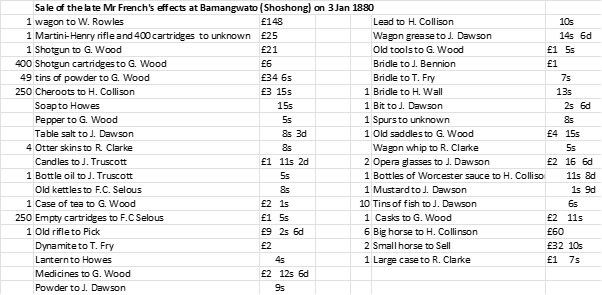Frederick Courteney Selous’ hunting trips from 1876 – 1885 with records from his original game book
Background
Frederick Courteney Selous needs no introduction to readers interested in the history of Zambesia; he ranks alongside Henry Byles, William Charles Baldwin,[i] Cigar, William Finaughty, Henry Hartley, Petrus Jacobs, Thomas Leask, John Lee, William Cotton Oswell,[ii] Cornelius van Rooyen, Jan Willem Viljoen, George Westbeech and George Wood. It was to these elephant-hunters, missionaries and traders that A Hunters Wanderings in Africa was dedicated.
His books relevant to this article are listed below, he wrote six books in all and many papers for the Royal Geographical Society and articles for The Field; the appendix to A Hunter’s Wanderings in Africa contains a summary list of game shot between the years 1877 – 1880 that agrees exactly with his game book, but I am not aware of any other writings specifically describing his game book.
Prior to the first entry in the game book, Selous and his hunting companion Cigar had already killed seventy-eight elephants from 1872 to 1874. During a four-month period alone in 1873 with George Wood he acquired, killed and bartered 5,000 lbs of ivory while hunting in the Zambesi Valley: buffalo, hippos, lions and rhinos together will all sorts of antelope, also fell regularly to his guns. Today his carefully catalogued game lists read like a record of slaughter, but it must be remembered Selous was hunting in an age when the supply of game in Africa seemed virtually inexhaustible.
From one end of the original game book that Selous kept between these years are daily details of the animals he shot and until 1880 even their location. In 1881 he missed the winter hunting season as he travelled to England. The daily count continues again from 1882, but without locations being noted and stops after the first few months of 1885 – although he continued to collect game specimens for museums.
In the preface to A Hunter’s Wanderings in Africa Selous writes: “At the end of the book I have appended some lists kept during my last two hunting expeditions. This has not been done out of any wish to show what a large bag I have made; but it has been copied from my game book, kept carefully from day to day…”[iii]
From the other end the game book contains lists of items stored in Selous’ wagons, an inventory of French’s items, lists of goods bought and amounts owing to and from other hunters and traders including James Dawson, George Wood, James Fairbairn, John Lee, Robert McMenemy, Harry Grant, George Martin, August Griete, Henry Collison, Solomon Vermaak – all well-known ‘interior men’ as well as items paid to French’s driver and other servants and amounts due to French’s estate. Also listed are orders from others such as John Lee, presumably when Selous went down to Klerksdorp, as well as amounts paid to his own drivers including Franz and Norris.
Selous as a youth
From his very earliest years Selous seems to have been drawn to adventure and natural history and read widely authors such as David Livingstone and William Charles Baldwin. Millais says when Selous was just ten years old a schoolmaster[iv] remembered: ... on going around the dormitories to see that all was in order, [he] discovered Freddy Selous, laying bare on the floor clothed only in his nightshirt. On being asked the cause of this curious behaviour, he replied "Well, you see, one day I am going to be a hunter in Africa and I am just hardening myself to sleep on the ground."[v]
1871
Selous first arrived in Africa on 4 September 1871 aged nineteen years old and still with the determination to become an elephant hunter.
1872
After a five month trading trip across Griqualand West[vi] and along the Orange river he left Kimberley in April with his companions George Dorehill[vii] and T.V. Sadlier[viii] for the interior. Frank Mandy[ix] joined them at Sechele’s, they were at Shoshong in mid-August, where following a chase by Selous and Dorehill after a herd of giraffe he became lost in the scrubby dry bush for four days and three nights and was helped back to the wagon by San Khoisan herders.
They arrived at Old Bulawayo in September. Dorehill and Mandy worked as traders. When George Phillips[x] interpreting, told Lobengula that Selous had come to hunt elephants, the King burst out laughing and said, “Was it not steinboks that you came to hunt? Why, you’re only a boy.”[xi] A day or two later the King gave permission for him to hunt saying, “Oh! You may go wherever you like; you are only a boy.” Selous and Sadlier accepted an invitation from Jan Willem Viljoen[xii] and his son to join their hunting party. They travelled together to Inyati Mission where Rev Sykes[xiii] told Selous that when he first came in 1859 they often saw elephants, buffaloes, rhinos and lion, but now the game had been driven far beyond the inhabited parts of Matabeleland.
He was to spend the next eighteen or so years in the region lying between the Limpopo River and the Congo Basin, hunting, trading, and exploring and he became known as one of the most daring and successful ivory hunters in Africa.
At the Viljoen’s camp on the Ngwenya river Selous was unable to hunt because of an injured foot and took a wagon to buy grain. At the Sebakwe river they found a camp of Boer hunters – Petrus Jacobs, probably the most experienced hunter in Southern Africa, had been badly mauled by a lion eight days before and was very ill and never fully recovered from this incident. The Viljoen’s failed to turn up, so Selous hunted on foot with Cigar[xiv] as his tutor from the Jomani river.
Selous had finished all his supplies of coffee, tea, sugar and meal and only ate native corn, meat and water. Cigar had two native hunters who carried their own guns and powder and three natives who carried his kit, Cigar carried his own heavy old 6-bore muzzle-loader. Selous had one native and carried his own 4-bore with leather bag filled with powder and twenty four-ounce round bullets.
They followed the spoor of an old bull and when they saw him slipped off their trousers – wearing just cotton shirts, hats and shoes - ‘nice light running gear.’ Selous fired the first shot at sixty yards aiming for the shoulder and the elephant rushed off. When Cigar fired the old bull advanced towards them, and from twenty yards Selous fired again into the shoulder, which brought him down with a crash. The old bull tried to get up, but could not, and one more shot from Cigar finished it off. His tusks were long and white and weighed 61lbs and 58 lbs. Next day Selous killed one more, Cigar killed four and his hunters another two.
Selous says that about this part of the country there were, at that time, many rhinoceroses, both square-mouthed and prehensile-lipped species (white and black) Later, he says they shot a white rhinoceros cow with a fine long horn measuring 3 feet 7 inches (109 cm) They hunted in November and December during the wet season in tsetse-fly country and Selous gained 450 lbs (204 kgs) of elephant ivory. Selous with Mandy and Dorehill, Cigar and other native hunters arrived back at Old Bulawayo on 20 December.
1873
From February to May 1873, Selous travelled with George Wood[xv] in Matabeleland mostly trading and watched the Inxwala[xvi] at Old Bulawayo in early February. Lobengula would not let them hunt in Mashonaland and told them they must hunt to the west of the Gwaai (Gwayi) river. They travelled up Lee’s road and hunted until November in the Linkwasha Valley and Dett.
Selous describes killing two bulls with just two shots; this was very unusual in those days with muzzle-loaders. The first elephant had tusks weighing 84 lbs, the other 82 lbs; the second had tusks weighing 59 lbs each. Shortly afterwards Mendose, one of his native hunters, fired at an elephant from behind Selous and ran up an anthill, another fired a shot that hit Mendose between the shoulder blades and killed him outright. He was buried in the anthill; Selous writes: “Poor Mendose! He was an obedient, willing servant and by far the best shot of all our native hunters.”[xvii] Selous killed 42 elephants, Wood about 50 and their natives hunting on halves added another 40.
1874
Wood and Selous traded again from mid-December to March 1874 and trekked south east from Old Bulawayo[xviii] to the confluence of the Ngesi and Lundi (Runde) rivers. In March, they travelled with James Fairbairn[xix] and James Dawson[xx] who had two fine loads of ivory to Tati – the journey that usually took just a few days lasted twenty-three days owing to the rains and flooded rivers. Wood stayed at Tati, the others including Frank Oates[xxi] left Tati and reached Shoshong on 11th April.
Selous writes that in the three seasons 1872-74 he shot seventy-eight elephants, all but one were shot on foot. The guns used by Dutch and native elephant hunters called roers were smooth-bore ‘duck guns’ of 4-bore (i.e. the bullet weighed four ounces) made by Isaac Hollis of Birmingham and he bought two weighing 13 lbs from William Williams, a trader at Kuruman for £6 each and these were used by him with another similar weighing 2 lbs heavier bought from a Dutch hunter.[xxii] They fired common black powder sold in 5 lb bags.
In later years Selous seems to have favoured a double-barrelled 10-bore because the 4-bores kicked “most frightfully and in my case the punishment I received from these guns has affected my nerves to such an extent as to have materially influenced my shooting ever since and I am heartily sorry that I ever had anything to do with them” but he adds he never used or saw a rifle that drove better than these common made old muzzle-loaders.[xxiii]
Black powder muzzleloaders fell out of favour as metal-cased cartridges and smokeless powder were introduced. He favoured a .256 Mannlicher for smaller game and a .450 Nitro Express, or a Martini-Henri .577/450.
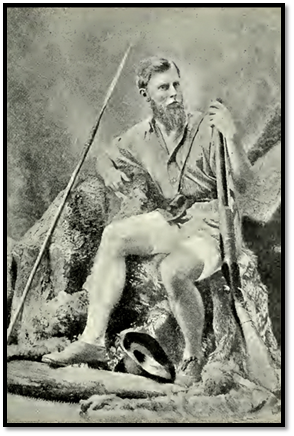
NAZ: London Studio portrait of young Selous about 1874 with a 4-bore muzzle-loader
1875
Selous was back at Tati on 11 December, but received news that caused him to leave Matabeleland on 1 February and return to England, only returning to South Africa in mid-March 1876.
1876
It took four months travelling by ox-wagon from Port Elizabeth (Gqeberha) before he arrived at Tati with Dorehill about 1 August. They went hunting with William Grandy[xxiv] and Lewis Horner[xxv] and for the next three months made short hunting trips along the Shashe, Tati and Ramaquaban rivers and had some success hunting giraffe. He writes, “that it is difficult to imagine anything more tasty than a steak off a young giraffe cow, when in good condition, though it may be that hunger, the sauce with which I have always eaten it, has something to do with it.”[xxvi] Selous and Grandy visited Old Bulawayo in October before returning and travelling some distance up the Westbeech road north of Tati in November.
Here Selous describes the dramatic moment after he wounded a lion and had to follow his spoor into a tangle of wag-‘n-bietjie (wait-a-bit) thorns and writes, “…I was peering about into the bush to try and catch sight of him, holding my rifle advanced in front of me and on full cock, when I became aware that he was coming at me through the bush. The next instant out he burst. I was so close that I had not even time to take a sight, but, stepping a pace backwards, got the rifle to my shoulder and when his head was close upon the muzzle, pulled the trigger and jumped to one side. The lion fell almost at my very feet, certainly not six feet from the muzzle of the rifle.”[xxvii]
Here he met George Westbeech[xxviii] who Selous says was responsible for eliminating slavery in the Barotse Valley. In 1871, when Westbeech first traded with Sipopa Lutanga, King of the Barotse, Portuguese traders were dominant, and they were trading in slaves as well as ivory. By bringing in better quality guns, gunpowder and trade goods he forced out the Portuguese traders and ended the slave trading.
Selous, Edwin Miller[xxix] and C. Bell[xxx] left Tati on 1 December with Selous’ wagon for Kimberley.
Selous’ game book

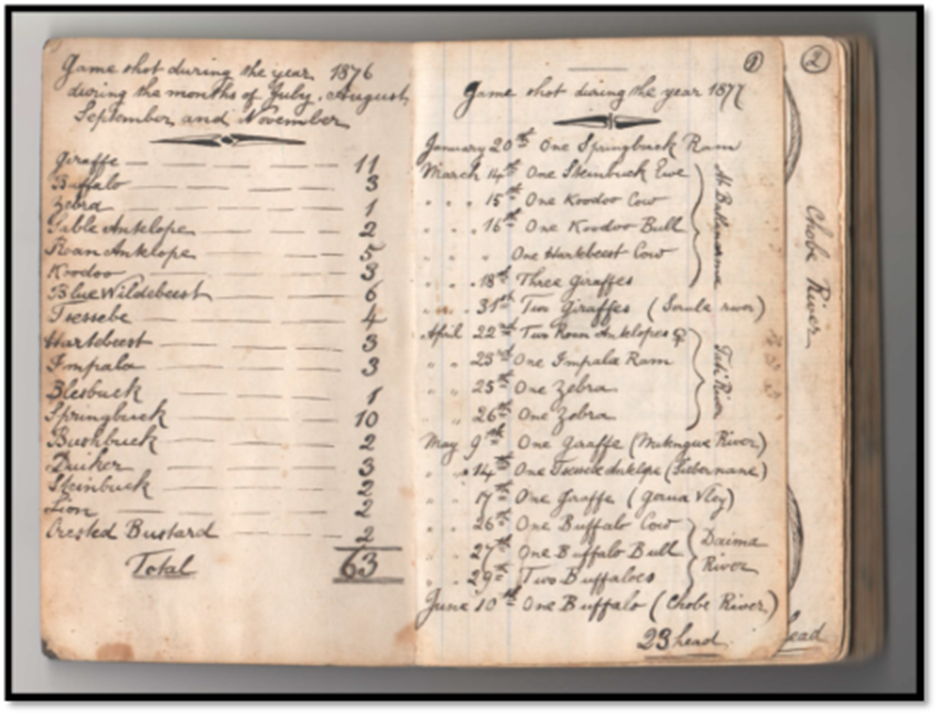
Selous’ game book for 1876 and 1877
1877
In April 1877 Selous accompanied by Kingsley and Edwin Miller – both shooting on halves, came to Tati from Kimberley. Selous rode to Old Bulawayo and having obtained Lobengula’s permission to hunt at the Zambesi Valley they trekked north on the Westbeech Road, and at Gerufa, met Dorehill, who went to the Zambesi with them. They made a stand place at the Deka river and with several native hunters on the Chobe river, but with little success, only Miller shooting an elephant cow and two calves. Selous gave up at Chobe in October, Kingsley and Miller took his two wagons to Tati.
Selous with L.M. Owen, Dorehill and Richard Frewin[xxxi] went shooting in the Berg in early October, then Selous and Owen with servants and donkeys followed the Deka river and crossed the Zambesi to Wankie’s town. They followed the Zambesi river on its north bank down to the Kariba gorge, crossed over and continued down to the Kafue river before crossing back and going northwest to Chitanda’s camp, south of the Lukanga swamps. All the while they suffered heavy rain, fever, little food, or game to hunt, and no help from local natives.
Selous’ game book

Selous Game book for 1877
1878
On the return journey fever nearly killed Owen, but Portuguese traders helped them to the Ume river, where on 4 April they crossed to the Zambesi’s south bank and Selous hired bearers to carry Owen in a litter up the Ume river. In its upper reaches on 17 April he left Owen[xxxii] in the care of two servants and with five others walked due south and reached Inyati Mission on 4 May 1878 where he rested for three weeks with the Elliott’s before staying a further two months with the Helm’s at Hope Fountain Mission.[xxxiii] He left with Jack Goulden[xxxiv] and reached the campsite of George Wood, Alfred Cross[xxxv] and Matthew Clarkson at the Umfuli (Mupfure) river on 11 September. Selous left his wagon at the Biri (rock rabbit) river and the five of them hunted between the Umfuli (Mupfure) Ganyana (Hunyani / Manyame) and Umsengaisi (Musengezi) rivers and the headwaters of the Umfuli and Umsweswe rivers. Between them and their native hunters they killed 104 elephants that season. They left the Umfuli on the 5 November, reaching the Viljoen’s camp at the Ngwenya and arrived at Inyati Mission to spend Christmas with the Elliott family. From here on 25 December he wrote the letter to his mother featured in the separate article.
Selous’ game book

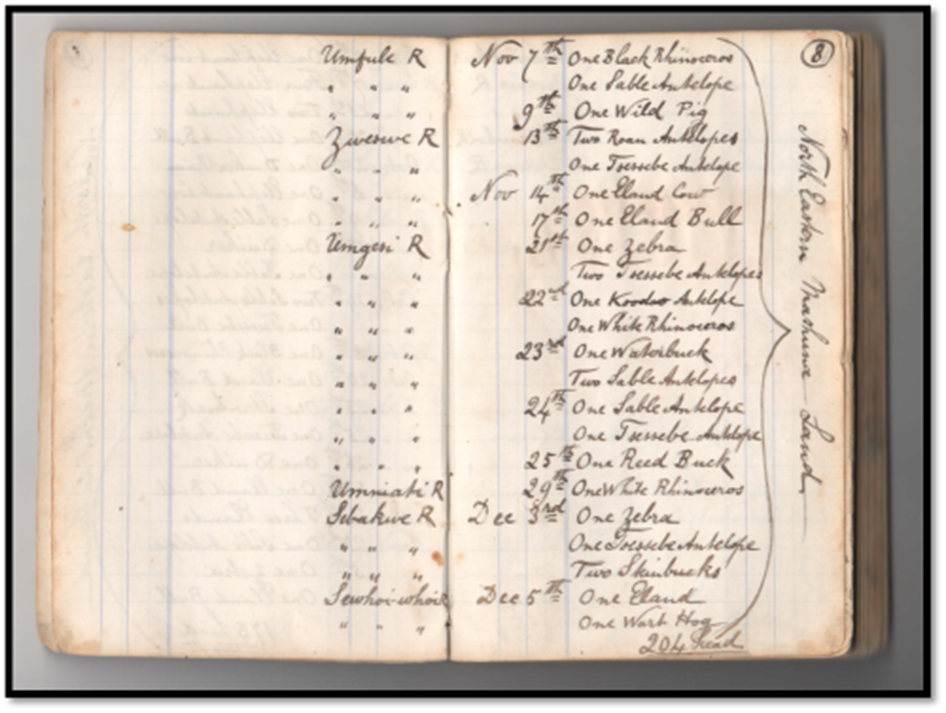
Selous’ game book for Nov / Dec 1878
1879
He was outfitting at Kimberley early in the year and hired Miller and Sell[xxxvi] to hunt on halves with him in the Zambezi Valley. They were at Shoshong in April and reached the Botletle river by May and the Mababe flats on 6 June. Here they met up with Henry Collison[xxxvii] and French.[xxxviii] It was a poor season and between them the hunters shot just fifteen elephants. French became lost north of the Chobe river and died about 25 September 1879; his servants only reached Selous’ camp on 2 October and said they would never be able to find their way back to his body. His companions took his wagon and effects out and Selous settled his estate at Kimberley[xxxix]
They did make a search for French’s body, but October that year was very hot, Selous was suffering from fever and although a reward was offered, no trace of French was found. Below is the list of French’s personal effects from Selous’ game book made a few weeks after his death and reflects what was usually carried by hunters at the time:
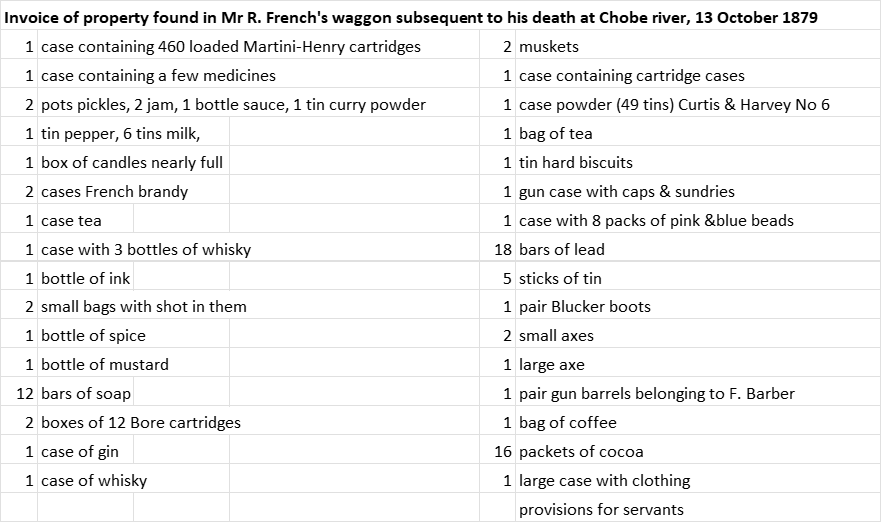
Once a list of French’s effects were made, the next item was to settle amounts due to his servants and driver Norris; details are contained within Selous’ game book.
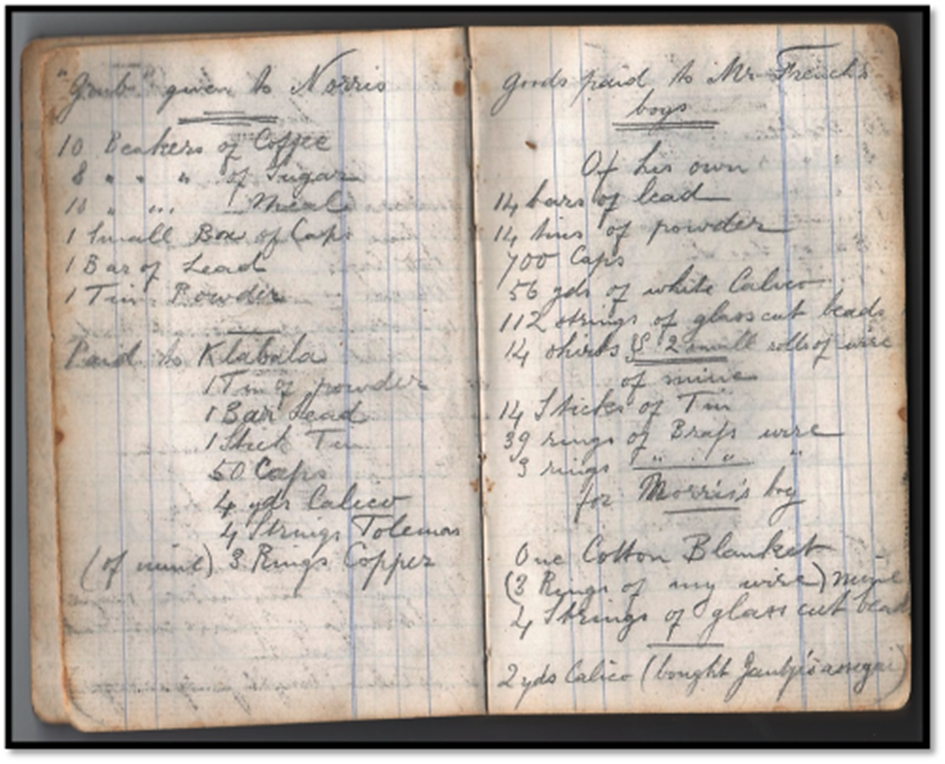
Selous’ game book showing goods paid as wages to French’s servants
Selous’ game book

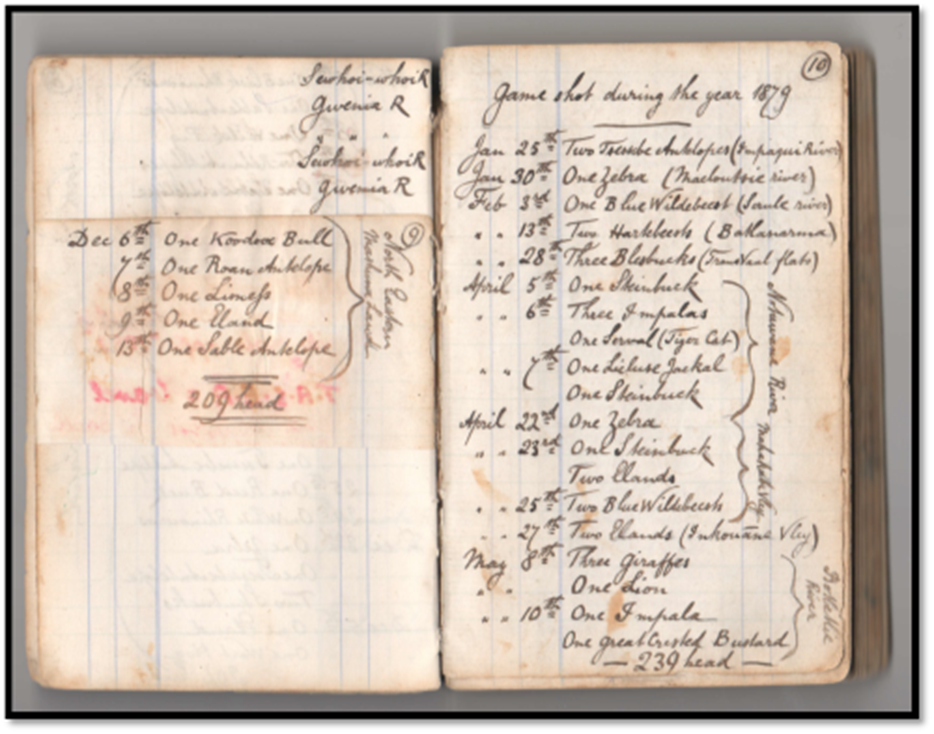
Selous’ game book for Jan / May 1879
1880
A general sale of French’s effects were made at Shoshong; Selous kept an accurate record of what was sold and what was paid or owed in his game book.[xl]
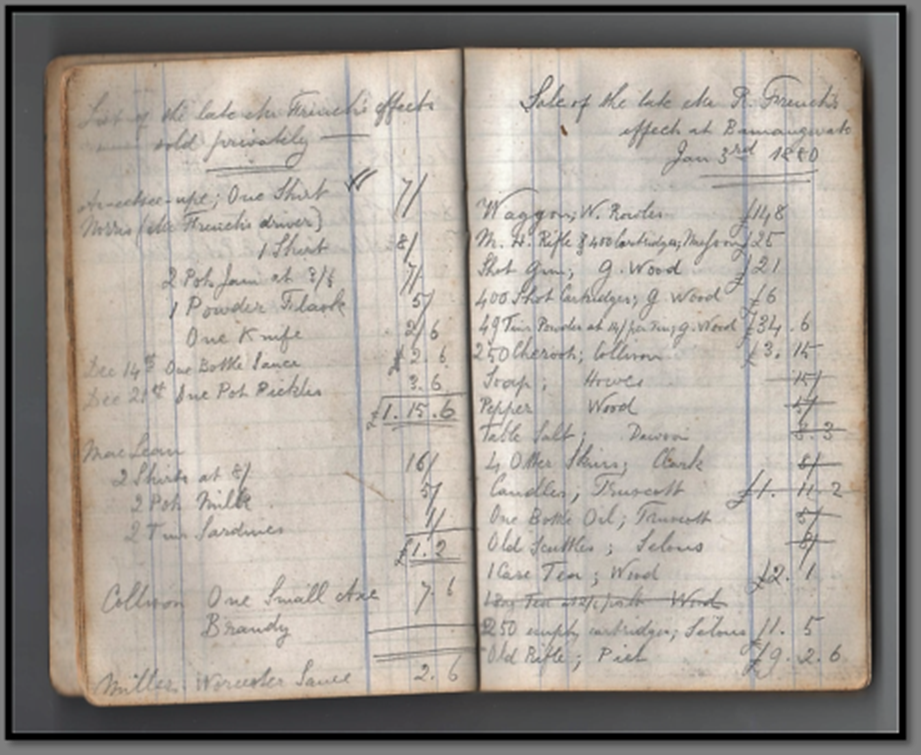
Selous’ game book with part list of French’s effects
Selous was in Matabeleland in May and on 9 June he, with Henry Collison, Dr Crook and J.S. Jameson left Inyati with Fr Augustus Law[xli] and his party of Jesuits and travelled together until they parted at the Sebakwe river. Selous and his party continued on the Hunter’s Road[xlii] and camped at Constitution Hill on the Umfuli (Mupfure) river. They hunted far and wide going north to Lomagundi’s kraal and south-east to the headwaters of the Umfuli river and towards Umtigesa’s kraal.
Selous’ game book

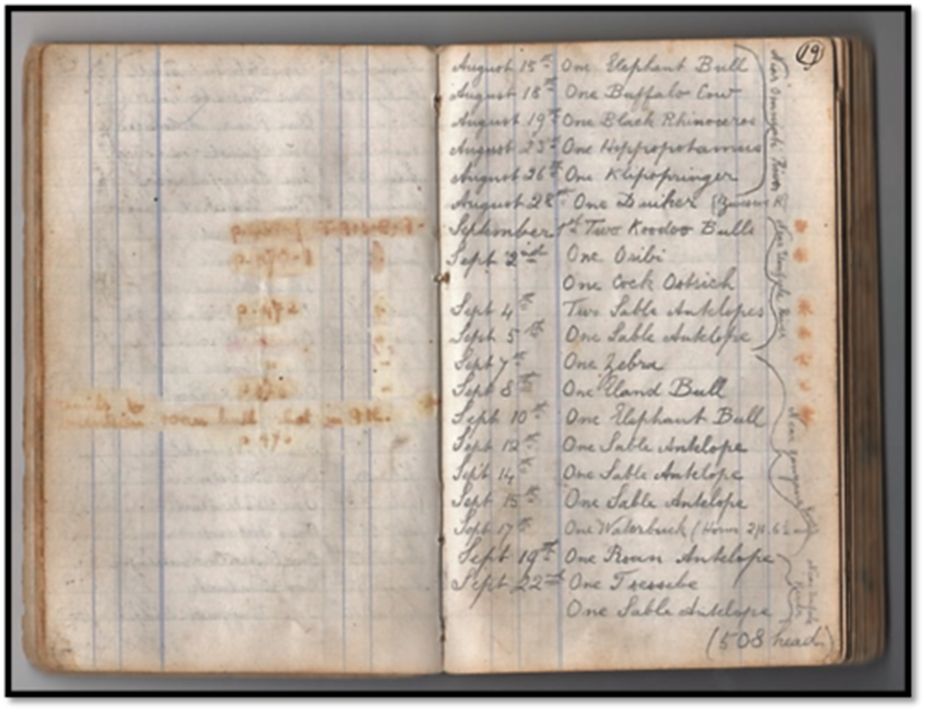
Selous’ game book for Aug / Sept 1880
On their return to their Umfuli camp – Dr Crook had been left in charge as he was not a keen hunter, they found a grave and a cross with the letters R.R. carved into a tree. They heard that on the night they left the wagons all were wakened by shrieking from ‘Susan’ - Jameson’s pet baboon. A lioness had got into their camp and seized old ‘Jordan’ one of Jameson’s horses. The natives shouting and firebrands drove the lioness away. Dr Crook set two trap guns at the hole in the fence where the lioness had come through. Next night the natives were by the fire when the lioness appeared and seized old Umzobo by the ankle; he with great presence of mind forced apart its jaws, and the lioness then caught Impewan by his buttocks until Ruthven fired his gun, whereupon the lioness let go and disappeared into the darkness. Dr Crook jumped out of his wagon to find poor young Ruthven with half his head blown off. It appears that Ruthven may have been sitting down when he fired and then jumped up as one of the drivers fired their gun. During the night the trap-guns went off and next morning the lioness was found dead and Dr Crook buried Ruthven.[xliii]
In November they returned to Old Bulawayo before leaving Matabeleland. Selous sold French’s effects to many of the traders in Matabeleland and Bechuanaland keeping detailed records of what was sold to whom, and what was paid and still owed.
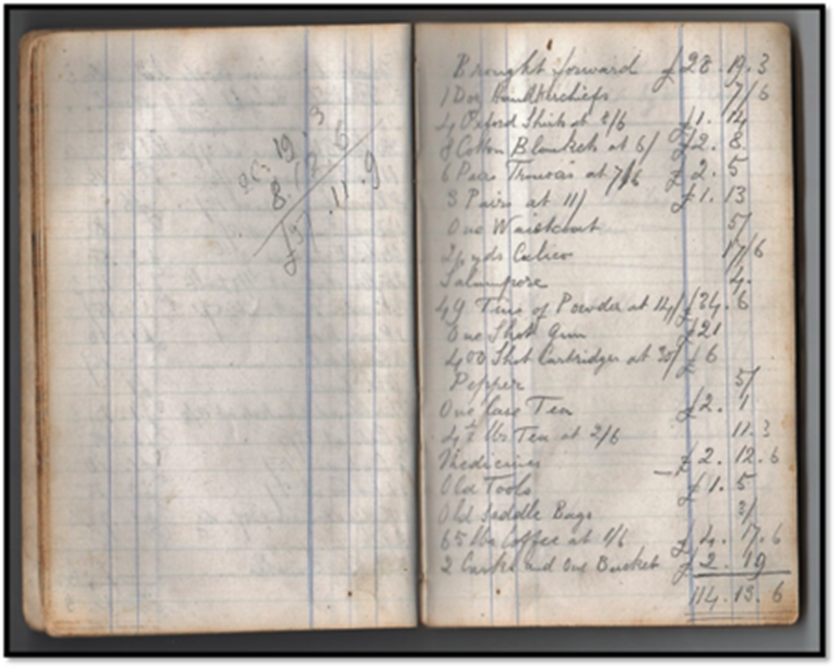
Selous’ game book with part of French’s effects sold to George Wood
1881
Kimberley was reached on 15 February 1881. Selous left for England from Port Elizabeth to oversee the publication of his book A Hunter’s Wanderings in Africa which became very popular and went through five editions. He visited the Natural History department of the British Museum and the curators showed him how old and dilapidated were many of the South African mammal specimens and he noted what specimens needed to be collected. In November 1881 he returned to Port Elizabeth, then Klerksdorp where he outfitted.[xliv]
He bought from Thomas Leask a wagon with a half-tent and a span of oxen and enough provisions and trading stock for a year’s trip and engaged Henry Collison’s driver Norris[xlv] and Laer, a young Griqua lad, who had been Collison’s ‘after-rider’ and whom Selous taught to help him in skinning and preparing skins for the museums.
1882
Selous took the missionary Frederick Arnot[xlvi] from Klerksdorp to Shoshong which they reached in March. This was Selous’ first season as a collector of museum specimens. He writes: “My days I spent in shooting and preserving antelope skins for mounting in museums or in collecting butterflies.”[xlvii] These butterflies were later presented to the South African Museum in Cape Town.
From 1882 he dropped elephant hunting and instead shot for museums[xlviii] and guided sportsmen. Selous writes in the preface to Travel and Adventure in South-East Africa: “During the first six years of that period, namely, from the beginning of 1882 to the end of 1887, I was principally engaged in collecting specimens of the magnificent fauna which once abounded throughout the land, but many forms of which are day by day becoming scarcer, while some, alas! are already verging upon extinction.”[xlix]
Selous’ game book

On 22 June he shot two lions[l] in the Lomagundi district after buying maize for his horses; a number of Mashona had accompanied him back in the hope of getting meat. The day he returned to camp (20 June) he rode out and shot three sable antelopes – a bull and two cows. Their glossy coats were in good condition and so they were skinned and the skins and meat brought back to camp. They set a trap-gun for hyenas that were being troublesome. That night he had just blown out his candle when Blucher his dog and two puppies started barking. They had started away from camp but were gradually coming closer. Suddenly Blucher’s deep bark stopped and the puppies rushed under his and Norris’s legs.
Now Selous took his double-barrelled 10-bore gun to where his servants had said they had seen an animal walking stealthily in the dark and squatted down peering intently into the darkness. After minutes with nothing seen Selous turned in again. After half an hour more barking and one of the servants shouting: “Here’s the lion, here’s the lion! He has taken a skin.” Sure enough, one of the sable skins was gone. Perhaps the lion would now be satisfied…he had taken Blucher the dog and a skin, so Selous turned in once again. After an hour, once again barking, and the puppies rushed into the scherm and another sable skin was gone!
Unable to sleep, Selous read by candlelight for perhaps an hour, when a box containing augers and other tools at the scherm entrance was violently moved. Norris under the wagon called out: “Master, master, hear the lion.” Once again he jumped out of the wagon with his rifle followed by Norris. The case was being moved, but the lion was not visible in the darkness, so Selous fired one barrel of the 10-bore into the case and then the other. No sound came from the lion, the dogs went quiet and the camp settled down, before Selous felt the wagon being slightly shaken, and the lion had entered their camp for the third time and taken the last remaining skin and was gnawing it in the darkness, apparently about thirty yards away.
He fired another shot, the sound stopped before a single growl was heard and the skin was dragged away. For the rest of the night Selous remained dressed and by the fire. Next day he and Norris saddled up two horses and as the dawn gradually came went to the scherm fence and saw a small shape in the valley that had not been there previously. Then he made out two lions: a lioness facing the camp and a lion broadside on gnawing at a skin. It was too dark to see the rifle sights and both lions went into the bed of a stream nearby, but despite riding out and patrolling the stream banks nothing was seen.
Next evening Blucher limped in with terrible wounds, but despite washing them and sewing him up, he refused food and became thinner and died. A gun-trap was made with the remains of the sable skin as bait; it went off in the night and next day they found a large spotted-hyena dead. The trap was re-set, but the next night there was no disturbance. Next day (22 June) Selous rode out with Laer and shot three tsessebe antelope. His servants were left skinning them, but as he rode back he heard shouting and turned back. Umlizan on an antheap shouted “lion, lion!” and only twenty yards away a lion was crouched perfectly flat on the ground and on the point of charging. Selous fired rapidly, the bullet struck exactly between the eyes and he set to work to skin it.
Once skinned, they set off for camp when Laer in front reined up and beckoned: “it’s another lion, sir!” “Where?” and as Selous dropped the lion skin another lion jumped up just fifty yards away and made for some forest cover. Selous dug in his spurs and after chasing three or four hundred yards, the lion stopped and turned, the end of its tail twitching from side to side. His horse would not stand still, so Selous dismounted and fired a bullet between the lion’s neck and shoulder; the lion reared up with a loud roar and fell sideways with Selous thinking: “I’ve got him.” But by the time he had settled his horse down and remounted, the lion was gone! Umlizan climbed a tree, but the lion could not be seen.
Selous walked into the grass, his gun cocked and ready for action. A blood track showed it had gone out the other side. He remounted and followed a faint trail about one hundred yards to another patch of grass and saw the lion lying stretched on the ground half on its side. “Here he is” he called to Laer when the lion sprang to its feet, growling savagely, and Selous wrenched his horse around, dug in his spurs and took off. However Lear’s pony shied and he fell off within thirty yards and was being dragged towards the lion, which had stopped advancing, but continued growling fiercely. Selous fired rapidly and his bullet hit the right eye. The lion was skinned, on cutting it open large pieces of sable skin were found in its belly, so it was definitely around their camp two nights before.
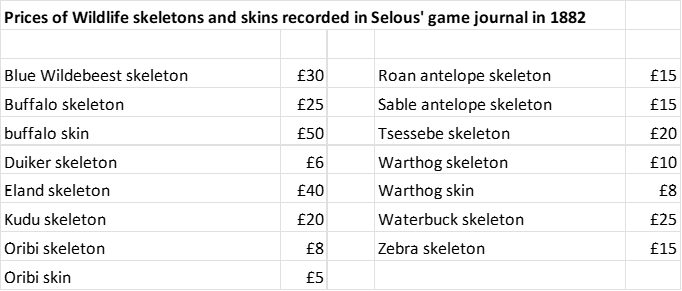
In July Selous shot one of just three leopards he notes in his game book. His friend George Dorehill had brought his wife and two children on a shooting trip into Mashonaland and was camped not far away. Selous decided to visit and in following Dorehill’s wagon tracks came across a black rhinoceros Dorehill had shot with a leopard feeding at the carcase and a lot of vultures sitting around at a respectable distance. The leopard was so busy feeding it never saw, or heard the horse, and Selous shot it between the shoulders; it was quickly skinned before he went on to his friend’s campsite.
On 6 August Selous set off from the Hunyani (Manyame) with Laer and seven servants and walked from his wagons to Zumbo on the Zambesi / Luangwa river confluence and a Portuguese trading post from the 17th Century and then back in August / September and in all that time, although he heard lion at night, he never caught sight of another. He writes there was plenty of evidence this portion of the country had been thickly populated with old rice fields, cleared forest and old remains of kraals, but the ever-present fear of an amaNdebele raid had driven the former inhabitants to the north and east. Although his own party only numbered ten, as soon as they were seen the people fled, the old women running from the fields wailing and shouting, the herd boys deserting their cattle and goats. He left Mashonaland early in October and returned to Klerksdorp.
1883
By May Selous was at the Ganyana (Hunyani / Manyame) river before taking his wagon to the Mazowe and then to Sabi (Save) river in July where he hoped to get specimens of the white rhinoceros for the British Museum.[li] The headwaters of the Mazoe (Mazowe) river he describes as: “without doubt the finest country for European occupation in South Africa” and thickly inhabited by Mashona people. There follows a six page description of a hunt for a fine cock ostrich that he wounded and whose feathers were ultimately collected by a Griqua hunter in his employ. They crossed the Ruwa river, a tributary of the Manyame river and a cluster of kraals under a headman named Entakwasheki and on the 23 July shot a magnificent old eland bull, sold to the British Museum, and two younger ones. The standing height of the old bull at the withers was 5 feet nine inches (175 cm)
The skin was prepared with arsenical soap, but at about 8pm that evening as the servants sat around the fires talking and laughing, a hyena crept through a break in the scherm fence, and made off with one of the prepared eland skins that Selous estimates must have weighed 40 lbs (18 kgs) He seized his rifle and with several of his servants carting bundles of blazing grass followed his barking dogs who managed to drive the hyena off and stood guard over the skin. “Such impertinence, however, could not be passed over…” and “as I knew that the enterprising beast would be sure to return before long, I determined to give him a warm reception.” He took his rifle and sat outside the scherm fence, and sure enough, after half an hour made out a dim shape in the darkness. When it was within seven or eight yards, he levelled his gun and fired. The hyena fell, then made off into the dark. The dogs were loosened and chased after the hyena until it jumped into a pool of water in a stream snapping at the dogs as they tried to seize it. The servants plunged their assegais into it from the high bank and it was soon done for, the Mashona saying it had lately killed three of their cattle and some goats.
Selous’ game book

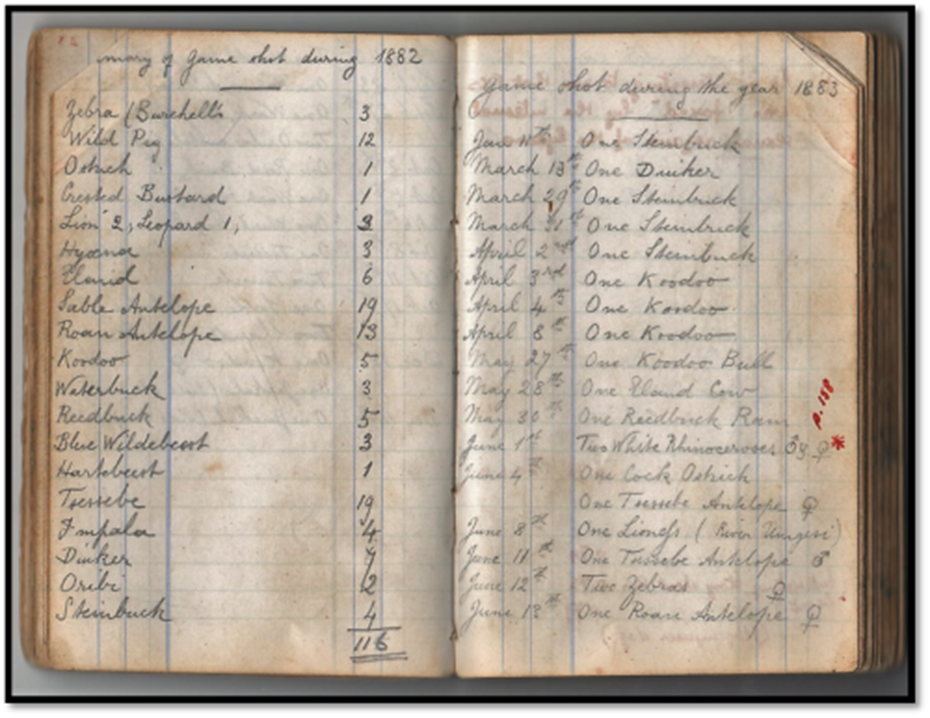
Selous’ game book for 1882 and Jan – June 1883
Local people said Lichtenstein’s Hartebeest was to be found about two days journey from Mount Wedza (Hwedza) and along the Sabi (Save) river and a few days later his guide pointed out where Fathers Law and Wehl had crossed the Sabi.[lii]
In November he met Harry Grant[liii] and Wynand[liv] at the Umsweswe river before returning to Matabeleland in mid-December. They were fined by King Lobengula and his indunas in the “sea-cow row” for killing hippos. Selous writes that white men resident in Matabeleland knew that the amaNdebele did not like hippo being killed wholesale, although they did not object to one or two shot for food. They believe a drought will follow the slaughter of a large number of hippo, unless their bones are thrown back into the river. In 1883, hippo hide sjamboks were in great demand in the Cape and the Transvaal and a Matabeleland trader, whose name began with M employed several Griqua hunters to shoot fifty hippo for him and cut their hides into sjamboks thinking King Lobengula would not hear of it. But the King heard of the enormous number being brought to M’s store and was summoned by him.
Selous was told by the King that he was angry that so many had been killed. He replied he had not seen a hippo in a year, but one of his wagon drivers, John Slaipstein, had shot a hippo on the Manyame river for food. The King only said: “That's nothing; there's no case against you, Selous” and shaking hands, they parted with Selous returning to his wagons at Emhlangeni. A few days later he received a summons to go to Gubulawayo. The messengers told him that four white men were to be tried by a council of headmen, including Selous, M, Piet Ostenhuisen and Harry Grant. Ostenhuisen had shot a few hippo's, but Grant had not killed a single one. The case lasted three days and they had to sit in the rain all day listening to the headmen trying the case.
When asked why he had shot the King’ sea cows, Selous said he had not done so, but they replied he sent his man to shoot them. They abused the others verbally, but to Selous said little, except that he was: “The witch who had killed all the King’s game” and that he would pay for the sea cow John Slaipstein had shot. The headman Ma-kwaykwi said: “it is you Selous who have finished the King’s game, but you are a witch, you must bring them all to life again. I want to see them – all, all. Let them all walk in at the kraal gate, the elephants and the buffaloes and the elands.” Selous stood up and said: “All right, but when the lions come in, will you, Ma-kwaykwi, remain where you are to count them?” This caused a general laugh at Ma-kwaykwi’s expense and quite stopped his flow of eloquence.
Lobengula then called out to Selous; ”why did you kill my sea-cows?” Selous denied it and he said: “well, you sent Moila (John’s native name) to shoot them…you say you will pay; what will you pay?” Selous said: “Two heifers” and Lobengula said: “you shall pay ten.” Presently the King retired and finally they had to pay. M[lv] paid £300 and Selous £60.
1884
Selous and W.M. Kerr trekked from Klerksdorp in March 1884 and met A. Kirton[lvi] who travelled with them from Ramoutsa to Shoshong. Selous and Kerr reached Gubulawayo by the end of April and parted there. Selous trekked north to the Mababe flats by June and during August retraced his route back on the Westbeech road and to Gubulawayo via Tati. He sent his skeleton and hide specimens back to the Transvaal Republic by a trader’s wagon and remained in Matabeleland.
Selous’ game book
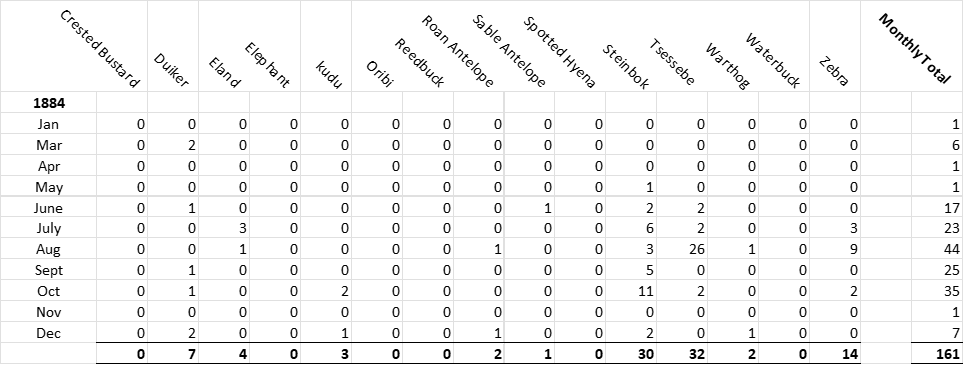
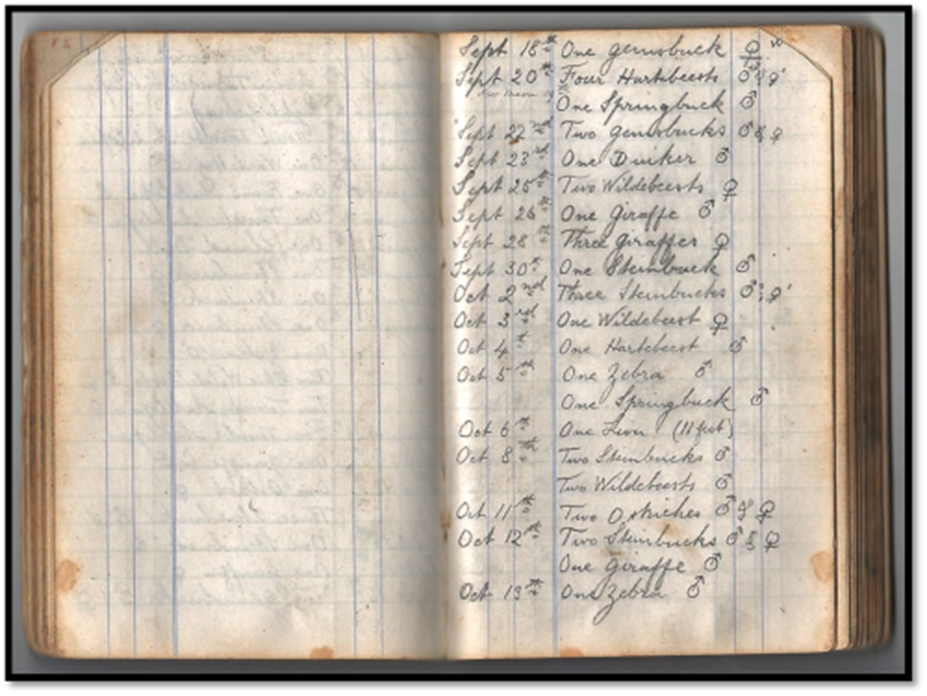
Selous’ game book for 1882 and Sept – Oct 1884
1885
Selous had a large number of unfulfilled orders for skins and skeletons of antelopes and other animals that were more plentiful in Mashonaland than anywhere else. He told the King that his heart was still sore at the way he had been treated in the ‘sea cow case.’ Lobengula replied: “Houw! that case is finished! Dead! What is the use of thinking any more about it? Go and hunt nicely until your heart is white” (i.e. until you are in a good temper) Lobengula demanded a salted horse, worth, say, 60 pounds for the right to hunting in Mashonaland, a high price to pay as elephants were no longer plentiful.
He started for Mashonaland in February, after visiting the Elliot’s at Inyati Mission, taking two wagons and thirty-two bullocks to pull them. Near the Se-Whoi-whoi (Kwekwe) river was where Selous had shot his last two white rhinos on 1 June 1883, a male and female and he says probably the last of their kind that he would ever see. He writes he would never cease to regret that he did not preserve the entire skeleton for the Museum of Natural History at South Kensington, but he was sure he would get finer specimens later on in the season. However, circumstances prevented his visiting the one district where he knew that they were still to be found and now these few have almost all been killed. He says to the best of his belief the great white or square-mouthed white rhinoceros, the largest of modern terrestrial mammals after the elephant, will in the course of the next few years become absolutely extinct. Selous hopes his readers will pardon him but the extinction of this huge quadruped had a melancholy interest for him when he remembered that twenty years before it was a common animal over an enormous extent of country in central South Africa.
On the Lundazi (Chirundazi) stream, a tributary of the Umfuli river on the 28 February Selous shot five elephants, four cows and a bull. At one point he came face to face with one of the elephants: “a large cow coming straight back towards me on the spoor of the herd she had left. The forest was very open about here and she saw me as soon as I saw her and raising her head and spreading her ears, charged forthwith, screaming loudly. Turning my horse, I galloped back for the rocks, but the stallion would not put out any pace and I could tell from the screams that the elephant was gaining rapidly upon me.
Hastily turning my head, I saw she was getting very near and knew she would soon catch me, so I resolved to dismount and run for the rocks. My stallion was in some respects a perfect shooting horse and immediately I leant forward and seized his mane, he stopped dead. I was off and in front of him in an instant and running for the rocks, which were not twenty yards away. As I got round the first rock, I turned and this is what I saw. The horse was standing absolutely still with his head up and his fore feet planted firmly in the ground, as if carved in stone, and the elephant, which had then ceased to scream and was making a curious rumbling noise, was standing alongside of him, smelling about with her trunk. In front of my saddle was tied a leather coat with a red flannel lining - a present the preceding year from my friend poor Montagu-Kerr and I suppose that the elephant must have touched the horse with her trunk, as he suddenly gave a jump around, throwing the red-lined coat into the air. He then walked slowly to the rocky ridge behind him and again stood still about fifteen yards away from the elephant. All this time I had been afraid to fire, for fear of exasperating the elephant, and causing it to kill my horse. I now, however, determined to do so and was thinking of firing for her brain, for she was very near me, when she raised her head and ears and came towards the rock screaming like a railway engine. She must have got my wind, I fancy, suddenly. However, she could not get it me without going round the other rocks and as she did so, she gave me a splendid chance at a distance of not more than fifteen yards. I fired into the centre of her shoulder and immediately the bullet struck her she stopped screaming and, dropping her ears, swerved off. She only ran a hundred yards or so and then fell over dead.” A month later they found the carcase of another bull elephant at the same spot – its tusks weighed 40 lbs each and were worth at least £40.
Selous camped at the Umfuli before hunting on the Ganyana (Hunyani / Manyame) with Cornelius van Rooyen[lvii] and Collison who joined him later. James Dawson came later in the season to help Selous with his specimens and trophies and the four left together in December.
Selous’ game book

On their way back, camped between the Umniati (Munyati) and Sebakwi (Sebakwe) rivers, Selous was seated on the fore chest of his wagon drinking a cup of coffee as the sun rose when a fine sable antelope came out of the forest and walked toward the grazing cattle. Van Rooyen fired from his wagon and wounded the sable which made off slowly towards a stream that ran down the slope. All the camp dogs – about twenty in number, rushed after it with Selous and van Rooyen chasing behind as they knew what damage the long curved horns could inflict. The sable was quickly shot, but not before four of their best dogs lay dead and another four were badly wounded, one of which subsequently died.[lviii]
1886
He travelled twice to Matabeleland, but with little hunting and collecting. In between trips he returned to England during August to September and was back at Gubulawayo towards the end of 1886.
1887
Selous guided J.A. Jameson, A.C. Fountaine and Frank Cooper on a Mashonaland shooting trip. Their stand place was on the upper Hunyani (Manyame) and they travelled far and wide across Mashonaland to the Angwa river being the first to record the Sinoia Caves in the 1888 Proceedings of the Royal Geographical Society and going as far east as the future site of old Umtali[lix] in Manicaland. He says the spoor made by their six wagons was still plainly visible in the sandy soil of the future site of Fort Charter in 1890.
The hunters and traders bought and sold goods between them. Selous had a system of listing items bought from him on the right-hand page of the game diary and items purchased by him on the left-hand page. The items would be priced and the net amount paid or received.
Cartridges, gunpowder, percussion caps, rifles, flour, meal, sugar, knives, cooking pots and kettles, safety matches, blankets, cotton and linen, beads, brass wire and tinned food were popular items. John Lee bought eau-de-luce which the domestic encyclopedia of 1802 states can be used ‘for curing the bites of vipers, wasps, bees, gnats, ants, and other insects, but also for burns, and even the bite of a mad dog, though not always with uniform success.’
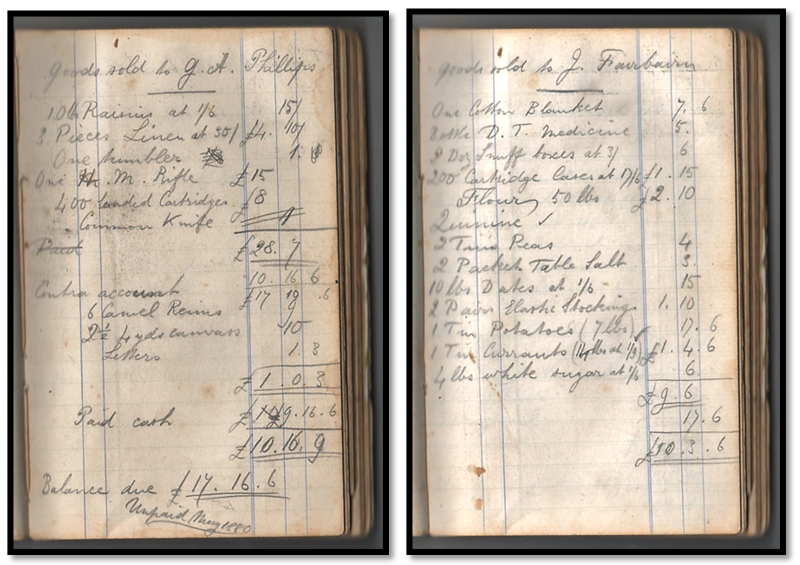
Selous’ game book listing items sold to George Phillips and James Fairbairn
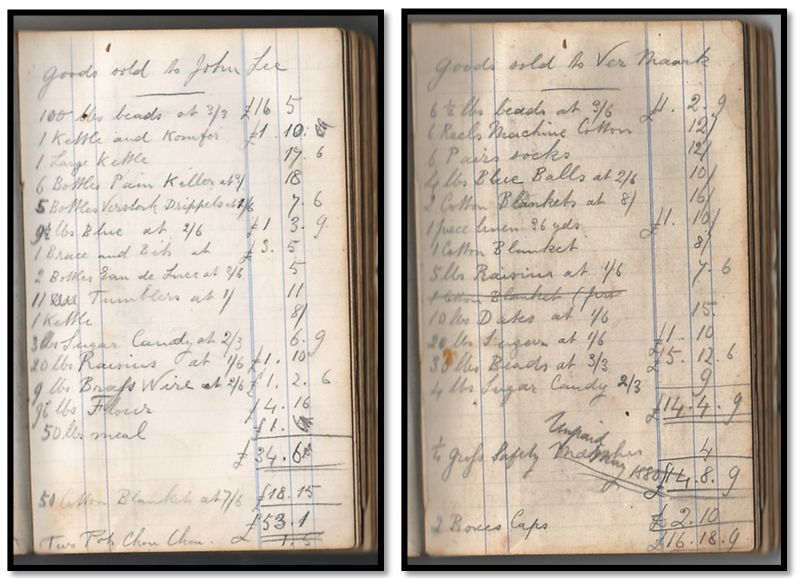
Selous’ game book listing items sold to John Lee and Solomon Vermaak
1888
Selous left Shoshong with two wagons on 9 April travelling the Makgadikgadi salt pans road and reaching Pandamatenga[lx] on 16 May and planning to go to Lealui in Barotseland. At Gazuma (Kazuma) pan he met his old friend George Westbeech who told him that Barotseland was closed because of internal conflict and said that Frederick Arnot had written to him saying there were elephants at Garanganze.[lxi] He left most of his goods and wagons at Pandamatenga and walked with donkeys and servants along the Deka river to Wankie’s kraal, a journey of eight days accompanied by Jan Weyers.[lxii]
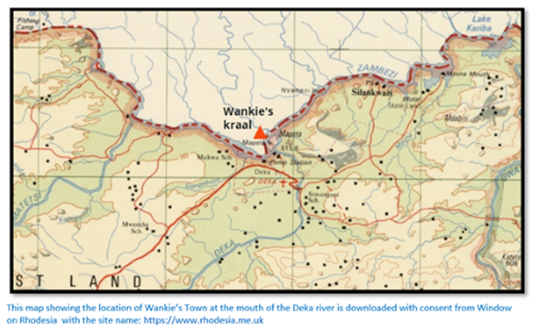
They travelled downriver by canoe making for the Kafue river and near his destination on the night of 8 July his camp was attacked and plundered by the Baila (Ila, Sukulumbwe or Shukulumbwe) who killed twelve of his men and carried everything away. Selous managed to escape in the darkness and confusion and with his surviving followers made their way back to Pandamatenga.
From there on 11 August he went to the Zambezi, and then to the Barotse capital at Lealui, reached on the 5 September. King Lewanika was hospitable, but Selous had nothing left to trade and left, reaching Kazungula on 12 October before visiting the Victoria Falls.
1889
Selous was at Shoshong in January 1889 where Frank Johnson[lxiii] hired him to take two prospectors, Edward Burnett[lxiv] and Steve Thomas to Mashonaland from the lower Zambezi river. He sailed to England and was back at Quelimane on the East African coast in July. They travelled to Mazaro (Maruro) and up the Zambezi river by light boat and native canoe through the Lupata gorge to arrive at Tete on 11 August. They hired forty-two carriers and followed a caravan route to Zumbo, but Selous decided they were going too far north, and hired a guide at Nyatsutsu and took the ancient route up the Luenha river. At Rusambo’s kraal Selous saw, one to each hut, the wooden dishes in which the women wash for alluvial gold – he saw the same wooden pans in Mashonaland. They took the northern tributary to follow the Mazoe river up to its headwaters and saw the peak called Fura that he says he had the impertinence to name Mount Darwin.[lxv] A gold mining concession was obtained from the local chiefs Temaringa and Mapondera on 25 September. Determined to find the headwaters of the Mazoe river Selous and Edward Burnett – Thomas was ill with fever; they followed its course to the Tatagura stream where they found a great many lemon trees and walked through the poort[lxvi] to find its source three hours later, below a swampy area. Selous alone continued on to Mount Hampden on the Gwebi river. They returned along the Mazoe river to Tete by the 24 October and reached Cape Town in December.
This trip convinced Selous of the threat of a Portuguese takeover and the need for urgent action – Rhodes was quick to understand the value of Selous’ name and used his arguments of the imminent Portuguese threat in the negotiations between the British South Africa Company and the British Foreign Office as leverage to obtain his Royal Charter.[lxvii] Although their characters were very different; Selous honest and sincere, Rhodes tricky and politically astute – their shared goal united them for a time.
1890
Selous was employed by the British South Africa Company from early 1890 to May 1892 initially as Intelligence Officer to the Pioneer Column[lxviii] and later to build a wagon road from Salisbury to Old Umtali in Manicaland.[lxix]
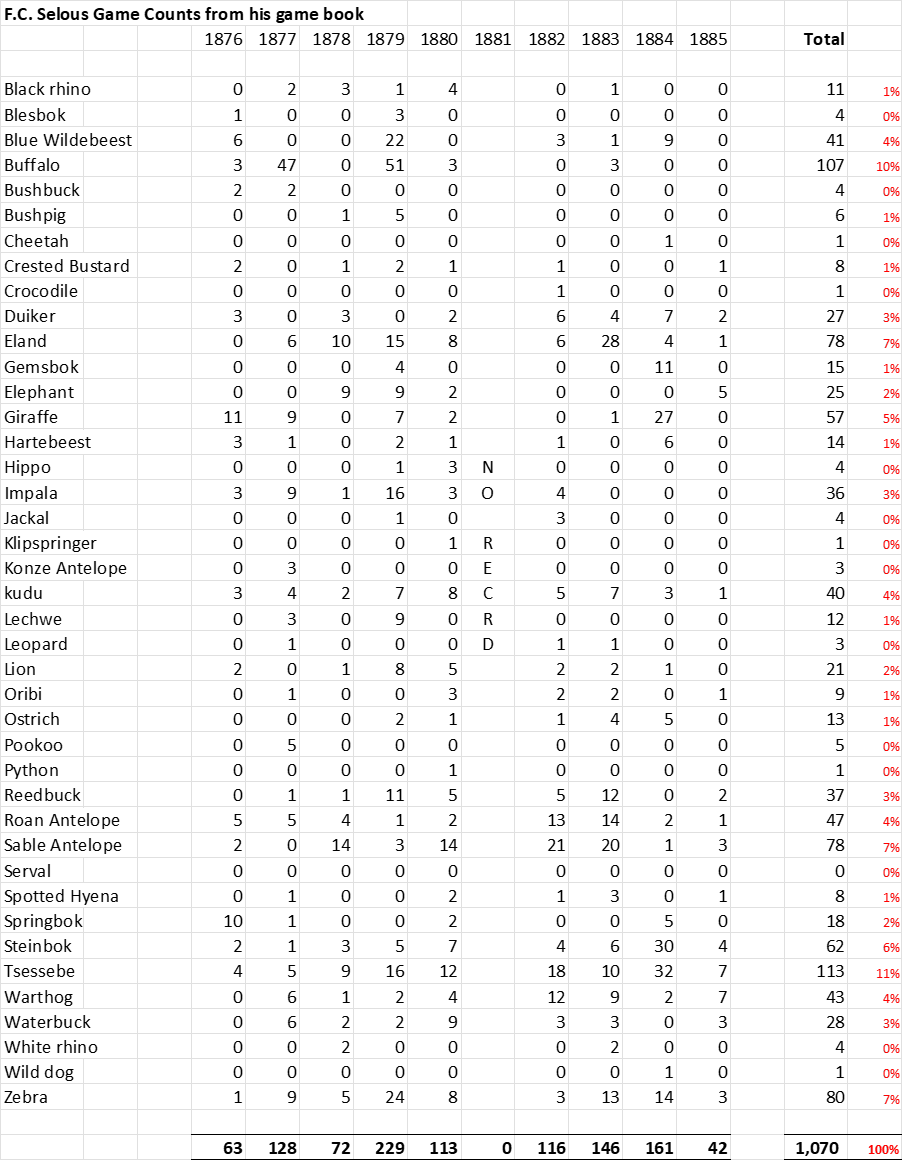
Selous shot comparatively few elephant during the years he kept his game book, despite their ivory being the staple and most lucrative commodity available – this was because the ivory trade was already in decline by the time he arrived in 1871, with the elephants gradually moving into the Zambezi Valley and the Lowveld, where a shooting horse could not be taken because of the prevalence on tsetse-fly. Malaria was also more of a problem for hunters and their servants here as well.
Acknowledgements
I wish to thank Lance Bradfield for very generously allowing me to use Selous’ game book for this article. Any reader who would like the Excel spreadsheet with the daily/monthly/annual figures from the game book should contact mikertuck1@gmail.com
References
J.G. Millais. The Life of Frederick Courtenay (sic) Selous, Longman, Greens & Co., London 1919
F.C. Selous. Travel and Adventure in South-East Africa. Books of Rhodesia Vol 25, Bulawayo, 1972
F.C. Selous. A Hunter’s Wanderings in Africa. Books of Rhodesia Vol 14, Bulawayo 1970
F.C. Selous game book 1876 – 1885
E.C. Tabler. Pioneers of Rhodesia. C. Struik (Pty) Ltd, Cape Town 1966
Notes
[i] Baldwin’s book African Hunting from Natal to the Zambezi (1864) was a favourite Selous book
[ii] Oswell also went to Rugby School, his portrait hangs by Selous' in the Temple Speech Room at Rugby
[iii] Preface to A Hunters Wanderings in Africa, Pviii
[iv] His House-master, Canon Wilson contributed to The Meteor of 7 February 1917 in a paper on "Reminiscences of his School Days at Rugby"
[v] The Life of Frederick Courtenay Selous, P13
[vi] Griqualand West was inhabited by the Griqua people and in In 1873 it was declared a British colony with the capital at Kimberley, but in 1880 was annexed by the Cape Colony and is now part of the Cape province
[vii] Dorehill arrived in South Africa in the same ship as Selous. He was employed by Kisch, a trader at Gubulawayo and went to Mashonaland in November 1872 to sell supplies to the hunting parties. Returned with Selous, Mandy and Cigar and left for the diamond fields with Mandy. He returned to trade in Matabeleland in 1874 and 1875, visiting the Victoria Falls and was trading and hunting in the Zambesi Valley in 1876 and 1877, some of the time with Selous. After a period in the Transvaal he joined Selous in Mashonaland on the Hunyane (Manyame) river in July 1882 doing some hunting and left with Selous in September.
[viii] Sadlier hunted in 1872 in Mashonaland with the Viljoen party, but quarrelled with them before returning to Gubulawayo and leaving Matabeleland
[ix] Frank Mandy lived at Grahamstown and made six annual trading journeys to Matabeleland from 1870. In 1872 after travelling with Selous, Dorehill and Sadlier he travelled to the Sebakwe river to sell supplies to the hunting parties before travelling east of the Hunyani with George Wood to buy grain from the Shona. In 1890 he was a lieutenant in B Troop of the Pioneer Column and later worked as a compound manager for De Beers at Kimberley
[x] George Phillips, hunter and trader first entered Matabeleland in 1864. A long-time partner of George Westbeech he was much trusted by Mzilikazi and Lobengula, left Matabeleland in 1890, lived almost continuously in Matabeleland for twenty-five years
[xi] A Hunters Wanderings in Africa, P29
[xii] Jan Viljoen fought against the British in 1848; as a consequence his farm was confiscated and trekked to the Marico district and named his farm Vergenoeg, ‘Far Enough.’ In 1851 he hunted at Lake Ngami with Chapman and from 1862-64 on the western edge of Matabeleland, in Mashonaland in 1872 with Selous and Sadlier, in 1873 he shot 17 elephants on the Semokwe river.
[xiii] Rev William Sykes of the London Missionary Society was at Inyati Mission from 1859 until his death on 22 July 1887 during the reigns of both Mzilikazi and Lobengula
[xiv] Cigar was a Khoisan hunter probably from the Western Cape who had hunted in the interior with the Jennings party in 1867 and he hunted with Finaughty on halves in 1869. Tabler writes that by 1872 he was a bold and successful foot hunter and a great teacher to Selous in elephant hunting on foot – a very dangerous occupation – in the tsetse-fly country where shooting horses could not be taken
[xv] George Wood features prominently in both Selous and Thomas Baines diaries. He emigrated from Yorkshire to Natal in 1865 and entered Matabeland the next year with his half-brother Thomas, his brother Swithin went to Lake Ngami. In 1867 he hunted at the confluence of the Gwelo (Gweru) and Shangani rivers and met Rev T.M. Thomas coming from the Zambesi along the Gwaai (Gwayi) river before going east of the Umniati (Munyati) Next year he went south-east to the headstreams of the Lundi (Runde) Tokwe rivers and the Ngesi rivers. In 1869 he hunted with Byles, Thomas McMaster (Henry Hartley’s son-in-law) at the Ramaquaban river where Firmin was killed by an elephant
[xvi] See the article The Great Dance or Inxwala Festival under Bulawayo on the website www.zimfieldguide.com
[xvii] A Hunters Wanderings in Africa, P88
[xviii] See the article Early traveller’s impressions of Gubulawayo and the article Gubulawayo, or Old Bulawayo (1870 – 1881) and the Indaba Tree both under Bulawayo on the website www.zimfieldguide.com
[xix] James Fairbairn was at the diamond fields but left because of his gambling losses and in 1872 became an agent for Cruikshank at Old Bulawayo. He then became Cruikshank’s full partner before ending the partnership in 1875 and was James Dawson’s partner from 1881-90. Fairbairn was known by all the hunters and traders in the interior. Fairbairn, Leask and Westbeech obtained a concession in 1884 from Lobengula for the gold mining and mineral rights between the Gwelo (Gweru) and Hunyani (Manyame) rivers that were sold by Thomas Leask to Rhodes in 1889 for about £20,000. Fairbairn and Usher were protected by Lobengula at Gubulawayo during the 1893 Matabele Invasion by the Chartered Company. H died at Inyati Mission on 11 April 1894
[xx] James Dawson also worked for Cruickshank in 1872-7 eventually leaving and forming a partnership with Fairbairn in 1881 at Gubulawayo. Along with Will Tainton and other traders he opposed the Rudd Concession because they wanted their own mineral grants. He left Gubulawayo with three of the King’s envoys to protest the Rudd Concession to the British at Cape Town but two of the envoys were shot dead at Tati due to an unfortunate misunderstanding. In 1894 at L.S. Jameson’s request he and O’Reilly searched for King Lobengula and found and buried the remains of Allan Wilson’s patrol.
[xxi] See the article The naturalist Frank Oates who visited the Victoria Falls on 31 December 1874 and died only 36 days later of fever under Matabeleland North on the website www.zimfieldguide.com
[xxii] Two guns were always used as an ‘after-rider’ reloaded each of a hunters guns as they were fired
[xxiii] A Hunter’s Wanderings in Africa, P10
[xxiv] William James Grandy was an ex-Lieutenant in the Royal Navy. He left his wife and daughter in Cape Town and 1876 was his first hunt in Africa. After this hunting experience with Selous, Dorehill and Horner he accompanied Selous to Old Bulawayo in October. The three companions, excluding Selous started with George Westbeech for the summer months of 1876-7 but all caught fever. He was back at Tati in April 1877 getting supplies before dying of fever on the return journey to Pandamatenga
[xxv] Lewis Horner with Grandy met Selous and Dorehill at Tati and hunted along the Shashe river before leaving with George Westbeech and Pandamatenga in the summer season of 1876-7. He was still ill with fever in June 1877 and left the country in July with Captain Robert Patterson
[xxvi] A Hunter’s Wanderings in Africa, P233
[xxvii] Ibid, P244
[xxviii] George Westbeech occupies over four pages in Tabler’s Pioneers of Rhodesia. He made his first trading trip into Matabeleland about 1864 and was at Pandamatenga, Barotseland or travelling in-between until his death on 17 July 1888 at Kalkfontein in the Transvaal Republic. He cut the road from Tati named after him [see the article George Westbeech and the road to Pandamatenga under Matabeleland North on the website www.zimfieldguide] was hugely influential with King Lewanika in Barotseland [see the article George ‘Joros’ Westbeech’s influence in the lower Zambesi Valley and his 1885-1888 diaries under Matabeleland North on the website www.zimfieldguide] ad his trading post at Pandamatenga was an essential stop for all visitors to the Victoria Falls and Barotseland
[xxix] Edwin Miller hunted on halves for Selous before leaving with him and Bell for Kimberley
[xxx] C. Bell had just completed an unsuccessful trip to the Zambezi Valley when he met Selous at Tati in November 1876 and travelled with him back to Kimberley. He was in Bechuanaland the following year
[xxxi] See the article Richard Frewen, the man who annoyed Lobengula and the consequent deaths of the Colonial government emissaries on their way to the Victoria Falls under Bulawayo on the website www.zimfieldguide.com
[xxxii] Rev Sykes Rev Sykes sent a party to rescue Owen who left Matabeleland
[xxxiii] See the article Hope Fountain Mission under Matabeleland South on the website www.zimfieldguide.com
[xxxiv] Jack Goulden initially traded at Old Bulawayo working for William Horn in 1875 and Matthew Clarkson’s partner in 1877 but took up hunting and was at the Nata river later in the year and looked after H. Barber when he was mauled by a buffalo. See the article Frederick “Freddy” Hugh Barber, hunter, trader, artist – visited the Victoria Falls in 1875 and Matabeleland in 1877 under Bulawayo on the website www.zimfieldguide.com He hunted with Selous, Clarkson, Cross and Wood in Mashonaland in the winter of 1878
[xxxv] Alfred Cross was William Tainton’s nephew and was Tainton and Alexander Browne’s partner until 1880 hunting and trading in the Zambesi Valley and Mashonaland
[xxxvi] Sell, a young German, hunted elephant around Dett in 1877 and stayed with the Barbers before hunting with Selous in 1879
[xxxvii] Henry Collison hunted in the Zambesi Valley in 1877 and Pandamatenga. Collison, French and Clarkson journeyed from Kimberley in early 1879 to meet up with Selous at the Mababe flats. Matthew Clarkson was killed by lightning north of Klerksdorp whilst sitting on the wagon fore chest talking to Collison during a storm.
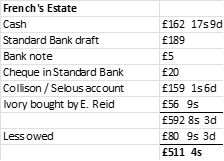
[xxxviii] French was described as ‘a gentleman by birth and education.’ He was at Old Bulawayo in 1875 when he assisted at Mrs Palmer’s funeral at Hope Fountain and later went lion hunting with Major Henry Stabb and Glascott. See the article Major Stabb’s hunting trip in 1875 to the Zambesi Valley via Gubulawayo under Matabeleland North on the website www.zimfieldguide.com. Whilst hunting with Selous, Miller, Sell and Collison he became lost north of the Chobe river on 25 September 1879 and was not seen again. Selous took his wagon and personal effects out with him and settled his personal estate at Kimberley
[xxxix] Selous game book records the following in French’s estate at a later date:
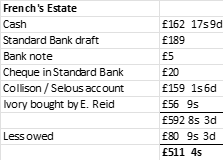
[xli] See the article The 1880 journey of Rev Father Augustus Henry Law S.J. and others to Mzila’s kraal in south-eastern Zimbabwe under Manicaland on the website www.zimfieldguide.com
[xlii] See the article The Hunter’s Road - followed on maps under Mashonaland West on the website www.zimfieldguide.com
[xliii] A Hunter’s Wanderings in Africa, P268-9
[xliv] Leask and Tayler was the most favoured outfitters at the time in Klerksdorp. See the article Thomas Leask’s Life and Diaries describing Matabeleland and Mashonaland in the 1860’s under Harare on the website www.zimfieldguide.com
[xlv] Norris had previously been employed by the deceased Mr French in 1879 – Selous’ game book has a note that he is owed £15 wages. Then employed by Henry Collison and from late 1881 by Selous
[xlvi] Frederick Arnot at was not associated with any missionary society at the time. Khama III welcomed at Shoshong and he stayed with the LMS missionary Rev J.D. Hepburn for three months and observed him at work saying he was "a faithful man, who sought the conversion not only of the natives of the tribe but also of every man who passed through Shoshong white or black.” He then continued to the capital Lealui of the Barotse kingdom where he stayed for eighteen months and persuaded Lewanika of the advantages of becoming a British protectorate
[xlvii] Travel and Adventure in Africa, P14
[xlviii] P. Emmerson in the foreword to the reprint edition of Travel and Adventure in South-East Africa writes that the Selous Collection at the Natural History Museum in London has 443 specimens of African game
[xlix] Preface to Travel and Adventure in South-East Africa, Pvii
[l] Travel and Adventure, P23-40
[li] Ibid, P73
[lii] See the article The 1880 journey of Rev Father Augustus Henry Law S.J. and others to Mzila’s kraal in south-eastern Zimbabwe under Manicaland on the website www.zimfieldguide.com
[liii] Harry Grant was a resident trader at Old Bulawayo from 1870 and thereafter. He built Lobengula’ brick houses with John Halyet. He leased a farm to the Jesuits and led the rescue party after Fr Law, but they were unable to cross the Sabi (Save) river owing to flooding and returned to Inyati in 1881. He had left Gubulawayo before the 1893 Matabeleland Invasion by the Chartered Company, but was probably the longest resident trader / hunter in Matabeleland
[liv] Karel Wynand hunted in Mashonaland with Engelbrecht in 1878, Grant in 1883 and Engelbrecht again in 1886
[lv] It seems likely that M the trader was George Martin who was hunting in Matabeleland in the 1870’s, then traded at Kanye in Bechuanaland before moving to Gubulawayo and from 1885 at the Inkwekwesi (Ingwingwisi) river that flows past Inyati Mission
[lvi] Argent Kirton, hunter and trader who married Rev T.M. Thomas’ daughter, later worked for Sir John Willoughby and was a captain in the Victoria Rangers. Killed with Wilson at Shangani on 4 December 1893
[lvii] Johannes Cornelius van Rooyen – first hunted on the western edge of Matabeleland in 1874 with his father and Piet Jacobs. Hunted most years thereafter in the Linkwasha Valley but with Selous and Collison in Mashonaland in 1885 and acted as a guide to sportsmen in the years following. He and Hans Lee were in charge at Mangwe laager during the 1896 Rebellion (Second Matabele War / First Chimurenga) Died at Plumtree
[lviii] Travel and Adventure, P191
[lix] See the article Old Umtali – the second site under Manicaland on the website www.zimfieldguide.com
[lx] See the article George Westbeech and the road to Pandamatenga under Matabeleland North on the website www.zimfieldguide.com
[lxi] en.wikipedia.org/wiki/Yeke Kingdom states that the Yeke Kingdom (also called the Garanganze or Garenganze kingdom) of the Garanganze people was in Katanga, DR Congo and was short-lived, existing from about 1856 to 1891 and controlled the only trade route across the continent from east to west, since the Kalahari Desert and Lozi Kingdom in the south and the Congo rainforest in the north blocked alternative routes. The period of the kingdom coincides with Selous in 1888, but it is quite the opposite direction from the Kafue river where Selous went!
[lxii] Jan Weyers hunted at Hendrik’s pan on the Westbeech road in 1877 with Meyer and hunted in the Zambesi Valley in 1878-9. Hunted on halves for and often with George Westbeech in the 1880’s using Pandamatenga as the base.
[lxiii] Frank Johnson was contracted by Rhodes to organise, train and provision the Pioneer Corps to Mount Hampden in 1890
[lxiv] Edward Burnett was appointed the chief transport officer of the Pioneer Corps and took over from Selous as intelligence officer when Selous resigned. Took part in Salisbury Column in the 1893 Matabele War and was killed near the Shangani river when his horse bolted
[lxv] Mount Darwin is named after Charles Darwin
[lxvi] The Mazowe poort is a natural gap in the Iron Mask Range
[lxvii] Indeed Emmerson in the foreword to Travel and Adventure in South-East Africa writes that Selous naivety was no match for Rhodes’ and his colleagues. The Chartered Company’s claim to occupation rights was based on the argument that Lobengula controlled all of Mashonaland – Selous knew that was not true, the Umfuli (Mupfure) was the eastern limit to most amaNdebele raids
[lxviii] See the article The Pioneer Column’s march from Macloutsie to Mashonaland under Harare on the website www.zimfieldguide.com
[lxix] See the article The Selous Road from Fort Salisbury to Old Mutare and beyond under Mashonaland East on the website www.zimfieldguide.com

